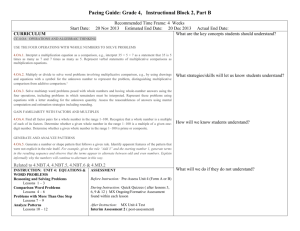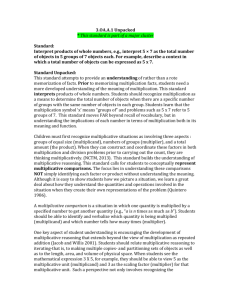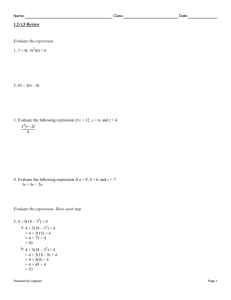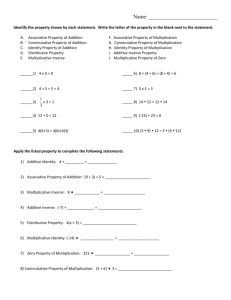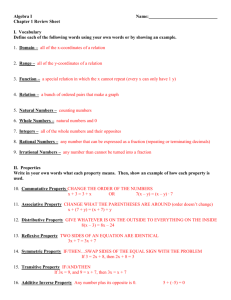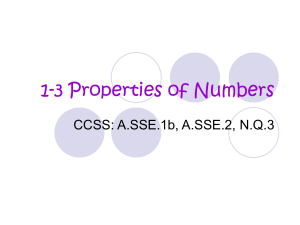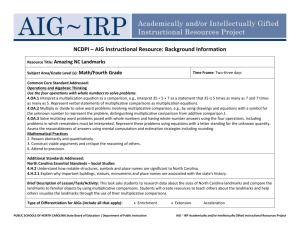4.OA_.A.1-Unpacked
advertisement
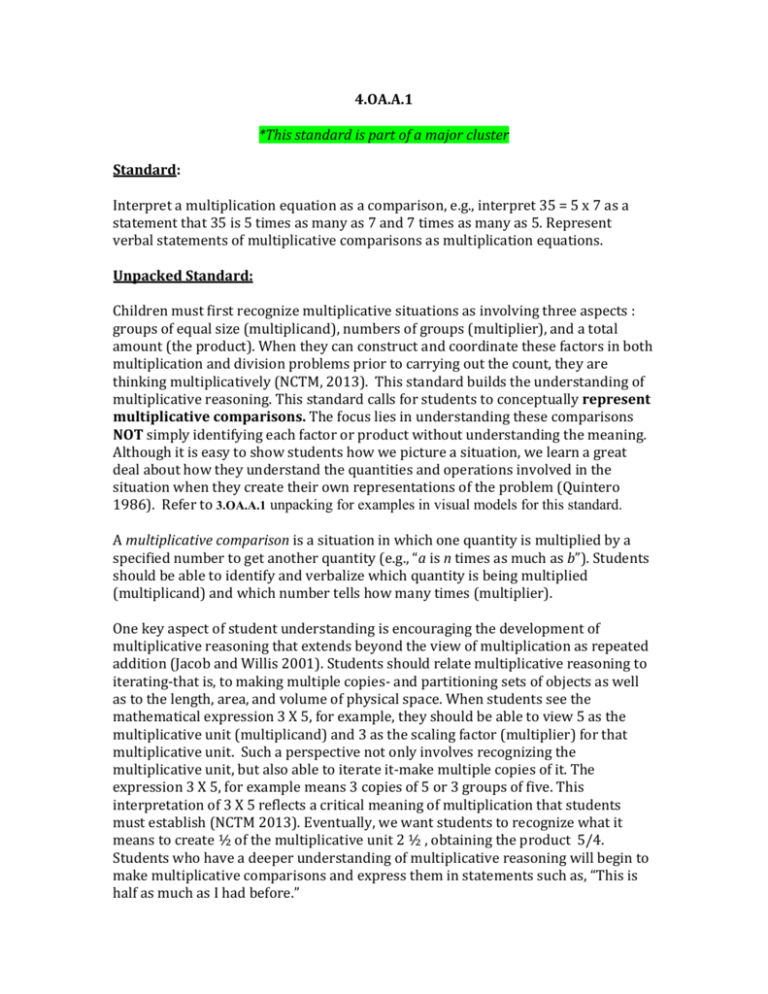
4.OA.A.1 *This standard is part of a major cluster Standard: Interpret a multiplication equation as a comparison, e.g., interpret 35 = 5 x 7 as a statement that 35 is 5 times as many as 7 and 7 times as many as 5. Represent verbal statements of multiplicative comparisons as multiplication equations. Unpacked Standard: Children must first recognize multiplicative situations as involving three aspects : groups of equal size (multiplicand), numbers of groups (multiplier), and a total amount (the product). When they can construct and coordinate these factors in both multiplication and division problems prior to carrying out the count, they are thinking multiplicatively (NCTM, 2013). This standard builds the understanding of multiplicative reasoning. This standard calls for students to conceptually represent multiplicative comparisons. The focus lies in understanding these comparisons NOT simply identifying each factor or product without understanding the meaning. Although it is easy to show students how we picture a situation, we learn a great deal about how they understand the quantities and operations involved in the situation when they create their own representations of the problem (Quintero 1986). Refer to 3.OA.A.1 unpacking for examples in visual models for this standard. A multiplicative comparison is a situation in which one quantity is multiplied by a specified number to get another quantity (e.g., “a is n times as much as b”). Students should be able to identify and verbalize which quantity is being multiplied (multiplicand) and which number tells how many times (multiplier). One key aspect of student understanding is encouraging the development of multiplicative reasoning that extends beyond the view of multiplication as repeated addition (Jacob and Willis 2001). Students should relate multiplicative reasoning to iterating-that is, to making multiple copies- and partitioning sets of objects as well as to the length, area, and volume of physical space. When students see the mathematical expression 3 X 5, for example, they should be able to view 5 as the multiplicative unit (multiplicand) and 3 as the scaling factor (multiplier) for that multiplicative unit. Such a perspective not only involves recognizing the multiplicative unit, but also able to iterate it-make multiple copies of it. The expression 3 X 5, for example means 3 copies of 5 or 3 groups of five. This interpretation of 3 X 5 reflects a critical meaning of multiplication that students must establish (NCTM 2013). Eventually, we want students to recognize what it means to create ½ of the multiplicative unit 2 ½ , obtaining the product 5/4. Students who have a deeper understanding of multiplicative reasoning will begin to make multiplicative comparisons and express them in statements such as, “This is half as much as I had before.” Students should be given ample opportunities to write and identify equations and statements for multiplicative comparisons. Example: 5 x 8 = 40. Sally is five years old. Her mom is eight times older. How old is Sally’s Mom? 5 x 5 = 25 Sally has five times as many pencils as Mary. If Sally has 5 pencils, how many does Mary have? Questions to check for understanding and increase rigor: Show students two rectangles (one of which is three times longer than the other). How do the sizes of the two rectangles compare? (multiplicative comparison is when one quantity (factor) is described by a multiple of the other, different than repeated addition and arrays) Model and explain your thinking. Martin and Kate used star stickers in a picture of the night sky. Kate used four times as many stars as Martin. How many stars could they have each used? Is there another possible answer? Describe the this situation with an illustration and statement. A plant was 2 inches tall on Day 1, it was measured at 10 inches on Day 12. How can you describe the relationship between the two quantities using multiplicative reasoning. Mark’s recipe calls for three times as many potatoes as carrots. If Mark uses two cups carrots, how many cups of potatoes will he use? Anna is 8 years old. Her mom is five times older than she is and her grandmother is eight times older than Anna. What multiplication sentences can be written to represent the relationship between Anna’s age and her mom’s age? between Anna’s age and her grandmother’s age? How old are Anna’s mother and grandmother? What multiplication equation and statement could you write to match the picture of the pencils?


